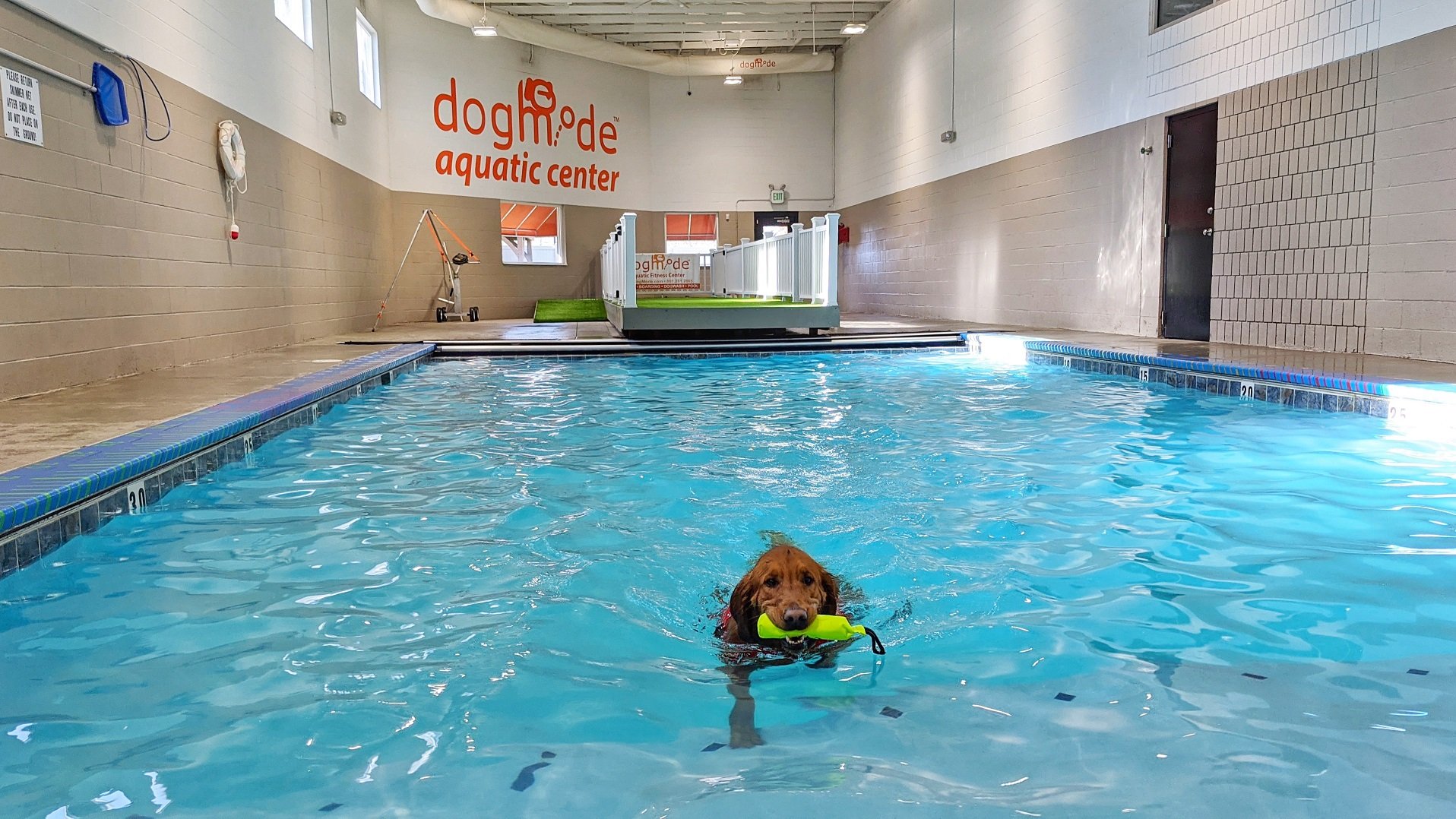Swimming for Dogs Near Me – Are you searching for the perfect swimming spot to take your furry friend? Look no further! In this article, we will explore the top-rated dog-friendly swimming spots near you. Whether you're looking for a calm lake or an adventurous beach, we've got you covered. So grab your pup's favorite toy and get ready for a splashing good time!
Factors to Consider When Choosing a Dog-Friendly Swimming Spot
Water Safety
When selecting a swimming spot for your furry friend, water safety should be your top concern. Look for locations with calm waters and minimal currents to ensure a safe swimming experience for your dog. Avoid spots with fast-moving rivers or dangerous undertows that could put your pup at risk. It's also important to be aware of any potential hazards in the water, such as sharp rocks or submerged objects.
Cleanliness
Choosing a clean swimming spot is essential for the health and well-being of your dog. Look for locations with clear, well-maintained water and clean shorelines. Avoid spots with excessive algae growth or signs of pollution, as these can pose health risks to your furry friend. Additionally, check if there are designated areas for dogs to swim, as some locations may have restrictions or specific cleanliness guidelines for dogs.
Accessibility
Consider the accessibility of the swimming spot, both for you and your dog. Look for locations with adequate parking facilities and easy access to the water. If your dog has mobility issues, ensure there are ramps or gentle slopes that allow them to enter and exit the water comfortably. Accessibility also includes the availability of amenities such as bathrooms, waste disposal stations, and picnic areas to enhance your overall experience.
Amenities Available
While not essential, amenities can greatly enhance your dog's swimming experience. Look for spots that offer facilities such as dog-friendly walking trails, shaded areas, or even dog wash stations where you can rinse off your pup after their swim. Having these amenities available can make your outing more convenient and enjoyable for both you and your furry friend.
Top Dog-Friendly Lakes for Swimming Adventures
Serenity and Space
If your dog prefers a calm and peaceful swimming experience, a lake can provide the perfect setting. Look for lakes that offer ample space for your pup to paddle around without feeling crowded. The serenity of a lake can create a relaxing environment for both you and your furry friend to enjoy.
Leash Policies
Before heading to a lake, familiarize yourself with the leash policies in place. Some lakes may require dogs to be on a leash at all times, while others may have designated off-leash areas. Understanding these policies will ensure that you are in compliance with the rules and can plan accordingly for your dog's swimming adventure.
Water Quality
Check the water quality of the lake before taking your dog for a swim. Look for lakes with clear, clean water that is safe for your dog to swim in. Avoid lakes with excessive algae blooms or signs of pollution, as these can be harmful to your furry friend's health.
Additional Amenities
Consider the availability of additional amenities that can enhance your dog's lake swimming experience. Look for lakes that offer convenient parking areas, picnic spots, and walking trails where you and your dog can explore before or after their swim. These amenities can add an extra element of enjoyment to your outing.
Local Recommendations
Seek out local recommendations for dog-friendly lakes in your area. Check online forums, dog-friendly websites, or ask fellow dog owners for their preferred lake spots. Local recommendations can often lead you to hidden gems that may not be widely known but offer fantastic swimming opportunities for your furry friend.
Discover the Best Beaches for Dog-Friendly Water Play
Sandy Shores and Gentle Waves
If your dog loves an adventurous swim, a dog-friendly beach is the perfect destination. Look for beaches with sandy shores and gentle waves, as these provide an ideal environment for your pup to frolic in the water. The soft sand offers a comfortable surface for them to run and play on.
Designated Off-Leash Areas
Check if the beach has designated off-leash areas for dogs. These areas provide a safe space for your pup to roam freely and enjoy the water without the constraint of a leash. However, it's important to respect and follow any rules or regulations set by the beach authorities.
Water Safety Measures
Ensure that the beach has proper water safety measures in place. Look for beaches with lifeguards on duty or areas with shallow waters that are suitable for dogs. Familiarize yourself with any warning signs or flags that indicate unsafe conditions, such as strong currents or high tides.
Facilities and Amenities
Consider the availability of facilities and amenities at the beach. Look for beaches that offer restroom facilities, ample parking space, and waste disposal stations for dog owners. Having these amenities available can make your visit more comfortable and convenient.
Local Rules and Regulations
Before heading to a dog-friendly beach, be aware of any specific rules and regulations in place. Some beaches may have restrictions on certain times of the day or certain areas where dogs are allowed. Being knowledgeable about these rules will ensure a smooth and enjoyable beach outing with your furry friend.
Safety Measures to Keep in Mind When Swimming with Your Dog
Life Jackets for Dogs
Consider using a life jacket for your dog, especially if they are not strong swimmers or if you're swimming in unfamiliar waters. A well-fitting life jacket can provide an added layer of safety and buoyancy, ensuring that your furry friend stays afloat and visible in the water.
Monitoring Water Conditions
Before entering the water, always assess the current water conditions. Check for any signs of strong currents, undertows, or sudden drop-offs that may be hazardous for your dog. Additionally, be mindful of water temperature, as extremely cold or hot water can be uncomfortable or even dangerous for your pup.
Gradual Introductions
If your dog is new to swimming or hesitant about entering the water, introduce them gradually. Start with shallow areas where they can comfortably touch the ground and gradually move into deeper waters as they gain confidence. Patience and positive reinforcement will go a long way in helping your dog feel at ease in the water.
Supervision at All Times
Never leave your dog unattended while swimming, even if they are experienced swimmers. Accidents can happen quickly, and it's important to be there to assist and ensure their safety. Keep a close eye on your pup and be prepared to step in if they show signs of distress or exhaustion.
Rinsing Off After Swimming
After your dog's swimming session, rinse them off with fresh water to remove any chlorine, salt, or other chemicals that may irritate their skin or coat. Pay special attention to their ears, as water trapped inside can lead to ear infections. Drying them thoroughly afterwards will prevent any discomfort or potential health issues.
Dog-Friendly Swimming Pools: A Great Alternative for Water-Loving Pups
Special Dog-Friendly Hours
Many swimming pools now offer special hours or designated days specifically for dogs to enjoy a swim. These dedicated times ensure a safe and enjoyable environment for both dogs and their owners. Check with local pools to find out if they have any dog-friendly hours that you can take advantage of.
Designated Areas for Dogs
Some swimming pools have designated areas where dogs are allowed to swim. These areas are typically separate from the regular swimming areas, ensuring the safety and comfort of all pool users. These designated dog areas often have shallow water levels and easy entry points for dogs to access the water.
Water Temperature Regulations
Swimming pools that cater to dogs usually regulate the water temperature to ensure the comfort of the pups. The water is typically set at a temperature that is safe and enjoyable for dogs, allowing them to swim and play without being too cold or too hot.
Rules and Etiquette
When visiting a dog-friendly swimming pool, it's important to follow the rules and etiquette set by the facility. This may include cleaning up after your dog, keeping them on a leash when outside of the pool, or limiting the number of dogs per owner. Respecting these guidelines ensures a pleasant experience for everyone.
Additional Amenities
Take note of any additional amenities that the swimming pool may offer for dogs. Some pools provide dog showers or rinsing stations so you can clean off your pup after their swim. Others may have grassy areas or shaded spots for dogs to relax and dry off. These amenities can add convenience and comfort to your swimming pool visit.
Essential Water Toys and Accessories for Your Dog's Swimming Excursions
Floating Toys
Invest in floating toys specifically designed for water play. These toys are typically made of buoyant materials that will stay afloat, making it easier for your dog to see and retrieve them in the water. Look for toys that are durable, waterproof, and safe for your dog to chew on.
Waterproof Fetch Balls
Waterproof fetch balls are a must-have for any swimming adventure with your dog. These balls are designed to float on water and are easy to throw and retrieve. Look for balls that are made of non-toxic materials and are large enough to prevent accidental swallowing.
Water-Resistant Floating Discs
Floating discs, also known as frisbees, are a fun and interactive water toy for dogs. Look for water-resistant discs that are lightweight and easy to throw. The bright colors and buoyant design will make them highly visible in the water, allowing your dog to chase after them with excitement.
Water Fetch Sticks
Water fetch sticks are a great option for dogs who enjoy retrieving objects from the water. These sticks are typically made of waterproof materials and are designed to float, making them easy to spot and retrieve. Choose sticks that are safe for your dog to chew on and are resistant to water damage.
Waterproof Dog Collars
Consider investing in a waterproof collar for your dog's swimming excursions. These collars are designed to withstand exposure to water, preventing them from becoming waterlogged or damaged. Waterproof collars are also easy to clean, ensuring that your dog remains comfortable and odor-free during their swim.
Dog Life Jackets
A dog life jacket is an essential accessory if your dog is not a strong swimmer or if you're swimming in unfamiliar waters. These jackets provide buoyancy and added safety, ensuring that your furry friend stays afloat and visible in the water. Look for a well-fitting life jacket with adjustable straps for maximum comfort.
How to Teach Your Dog to Swim: Step-by-Step Guide
Start with Shallow Water
Begin by introducing your dog to shallow water where they can comfortably touch the ground. This helps build their confidence and allows them to get used to the sensation of being in the water. Gradually increase the depth as they become more comfortable.
Positive Reinforcement
Use positive reinforcement techniques such as treats, praise, and play to encourage your dog to enter and stay in the water. Reward them for taking small steps, such as dipping their paws in the water or venturing a little further. This positive experience will help them associate swimming with something enjoyable.
Support Your Dog
While your dog is learning to swim, provide physical support by placing your hands under their belly or using a buoyancy aid like a life jacket. This will help them feel more secure and prevent any panic or anxiety. Gradually reduce the amount of support as they gain confidence in the water.
Encourage Paddling Motions
Show your dog how to paddle their legs and keep their head above water. You can gently hold their hind legs and guide them through the motions. Encourage them with verbal cues and rewards when they paddle successfully. It may take time for them to coordinate their movements, so be patient and supportive.
Practice Retrieval in Water
If your dog enjoys playing fetch, incorporate water retrieves into their swimming lessons. Start with shallow water and gradually increase the distance they need to swim to retrieve the toy. This will help build their swimming skills while keeping the activity fun and engaging.
Ensure Safety at All Times
Always prioritize safety when teaching your dog to swim. Supervise them closely, especially in open water, and be prepared to step in if they show signs of distress or fatigue. Additionally, be mindful of water conditions, such as strong currents or rough waves, that may pose risks to your dog's safety.
Health Benefits of Swimming for Dogs: Keeping Them Fit and Happy
Low-Impact Exercise
Swimming provides a low-impact form of exercise for dogs, which is especially beneficial for those with joint issues or mobility limitations. The buoyancy of the water reduces the stress on their joints, allowing them to engage in physical activity without putting excessive strain on their bodies.
Cardiovascular Health
Swimming is an excellent cardiovascular workout for dogs. It helps improve their heart and lung function, promoting a healthy cardiovascular system. Regular swimming sessions can help strengthen their heart muscles, improve circulation, and increase their overall stamina and endurance.
Muscle Strength and Tone
Swimming engages a wide range of muscles in a dog's body, providing a full-body workout. The resistance of the water helps to build muscle strength and tone, particularly in their legs, shoulders, and core. Regular swimming can help dogs develop stronger muscles, leading to improved mobility and agility.
Weight Management
Swimming is an effective exercise for weight management in dogs. It burns calories and helps to maintain a healthy weight, reducing the risk of obesity-related health issues. Swimming also allows overweight or obese dogs to exercise without putting excessive strain on their joints, making it a safer option for them.
Mental Stimulation
Swimming provides dogs with mental stimulation and enrichment. It engages their senses as they navigate through the water, stimulating their minds and keeping them mentally sharp. Swimming also offers a change of environment and the opportunity to explore new sights, sounds, and smells.
Stress Relief
Swimming can have a calming effect on dogs and help reduce stress and anxiety. The rhythmic movements and the soothing nature of the water can help them relax and unwind. Swimming also releases endorphins, which promote feelings of happiness and well-being in dogs.
Dog Hygiene: Post-Swim Care Tips for a Clean and Healthy Pup
Rinse Off Chlorine or Saltwater
After your dog's swim, rinse them off with fresh water to remove any chlorine or saltwater residue from their fur and skin. This helps prevent skin irritation and keeps their coat clean and healthy. Pay special attention to areas like their belly, paws, and tail, as these are more prone to accumulating residue.
Dry Thoroughly
Ensure that your dog is thoroughly dried after swimming. Moisture trapped in their fur can create a breeding ground for bacteria and lead to skin issues. Use a towel or a pet-specific drying towel to remove excess water, and consider using a blow dryer on a low setting to dry their fur completely. Pay extra attention to their ears, as moisture in the ears can lead to ear infections.
Check for Skin Irritation
Inspect your dog's skin after swimming for any signs of irritation or redness. Chlorine or saltwater can sometimes cause skin dryness or sensitivity. If you notice any irritation, consult your veterinarian for appropriate treatment options. Regularly brushing your dog's coat can also help remove any tangles or mats that may have formed during swimming.
Monitor Ears for Infections
Keep a close eye on your dog's ears after swimming, as moisture in the ear canal can lead to ear infections. Check for any signs of redness, itching, or discharge. If you notice any abnormal symptoms, consult your veterinarian for a thorough examination and appropriate treatment.
Nail and Paw Care
Inspect your dog's nails and paw pads after swimming. Water activities can sometimes cause nails to become softer, making them more prone to splitting or breaking. Trim any overgrown nails and check for any cuts or abrasions on their paw pads. Applying a dog-safe paw balm can help keep their paw pads moisturized and protected.
Regular Grooming
Keep up with regular grooming routines for your dog, which include brushing their coat, trimming their fur, and cleaning their teeth. Regular grooming not only helps maintain their overall hygiene but also allows you to spot any potential issues or abnormalities early on.
Exploring Dog-Friendly Swimming Spots: A Fun Activity for You and Your Canine Companion
Bonding Opportunity
Swimming with your dog provides a wonderful opportunity to strengthen the bond between you and your furry friend. It allows you to engage in a shared activity, creating memorable experiences and building a deeper connection. The joy and excitement of swimming together can create lasting memories.
Discover New Destinations
Exploring dog-friendly swimming spots opens up a whole new world of destinations for you and your dog to discover. It encourages you to venture out and visit different lakes, beaches, or swimming pools, providing a change of scenery and the opportunity to experience new environments together.
Meet Other Dog Owners
Dog-friendly swimming spots often attract other dog owners who share the same passion for water activities. It's a chance to meet like-minded individuals and their furry companions, fostering socialization for both you and your dog. You may even find new friends or potential playmates for your pup.
Outdoor Exercise
Swimming is a great form of outdoor exercise for both you and your dog. It allows you to stay active and maintain a healthy lifestyle. Swimming engages different muscle groups, providing a full-body workout. It's a refreshing alternative to traditional land-based exercises.
Escape the Heat
Swimming is an excellent way for both you and your dog to beat the heat during hot summer months. It offers a cool and refreshing escape from high temperatures, allowing you to enjoy the outdoors without overheating. It's a fun and practical way to stay cool and comfortable.
Create Lasting Memories
Swimming with your dog creates lasting memories that you can cherish for years to come. The laughter, joy, and shared experiences in the water will be etched in your mind. These memories will remind you of the special bond you have with your canine companion and the adventures you've shared together.
In conclusion, swimming can be a fantastic activity for dogs, providing them with exercise, mental stimulation, and a chance to cool off during hot weather. By considering factors such as water safety, cleanliness, accessibility, and amenities, you can find the perfect dog-friendly swimming spot near you. Whether it's a serene lake, an adventurous beach, or a dog-friendly pool, there are plenty of options to explore. Remember to prioritize safety, teach your dog to swim gradually, and take care of their hygiene after swimming. With these tips in mind, you and your furry friend can enjoy countless hours of fun and bonding in the water. So dive in, make a splash, and create lasting memories with your canine companion!

As a passionate water enthusiast, I've spent my life exploring the depths of swimming and sharing my experiences with the world. Stroke Swimming is more than just a blog; it's a deep dive into the world of swimming. Here, you'll find a treasure trove of information, tips, and insights to help both beginners and seasoned swimmers enhance their skills, knowledge, and appreciation for this timeless art.





